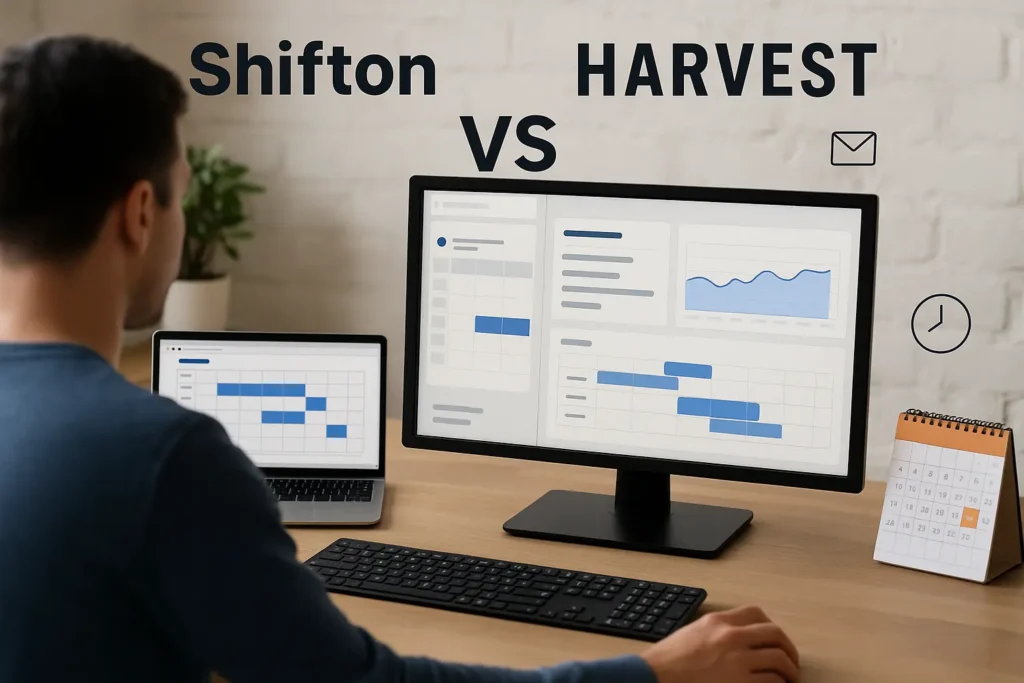In today’s fast-paced and increasingly digital work environment, businesses need robust scheduling and workforce management tools that optimize employee productivity and simplify administrative tasks. Two tools that often come up in this space are Shifton and Harvest. While both platforms offer valuable features, Shifton emerges as the more comprehensive, scalable, and cost-effective solution—especially for teams looking to go beyond simple time tracking and into full workforce management. This article will explore how Shifton compares to Harvest, with a deep dive into pricing, features, and advantages for businesses of all sizes.
What is Shifton?
Shifton is an advanced employee scheduling and workforce management software designed to handle everything from shift planning and employee notifications to attendance tracking and holiday management. Whether you're managing a team of five or five hundred, Shifton streamlines workflows through automation, real-time updates, and highly customizable modules. It is particularly suited for businesses in sectors such as healthcare, logistics, hospitality, and customer support—industries where shift-based work is common.
At its core, Shifton aims to reduce the administrative burden associated with manual scheduling and improve overall team coordination. With prices starting at just $1 per employee per month, it offers unmatched value in terms of features and flexibility.
What is Harvest?
Harvest is primarily known as a time tracking and invoicing tool. It helps freelancers, agencies, and small businesses track hours worked, generate client invoices, and report on billable time. While it excels in its niche, Harvest lacks the robust workforce scheduling capabilities required by shift-based organisations.
Its core functionalities are geared toward remote teams and service-based businesses rather than operations-heavy environments. This makes Harvest a less suitable choice for companies that need real-time shift updates, location tracking, or push notifications for urgent tasks.
Feature Comparison: Shifton Outpaces Harvest
To understand how Shifton stands out, let’s compare key functional areas:
1. Shift Scheduling and Automation
Shifton includes an intuitive Schedule Creation Wizard, Open Shifts, Shifts Swapping, and Manual Schedule Editing, all available at the base rate. It allows managers to plan complex schedules, assign open shifts, and let employees swap shifts within policy limits.
Harvest, on the other hand, does not offer shift scheduling or shift swap functionality at all. It is purely focused on tracking the hours already worked.
2. Mobile App and Real-Time Notifications
Shifton’s mobile app ensures that employees are always connected to their schedules. Push and email notifications alert users about changes, shift reminders, and approvals.
Harvest offers a mobile app, but it is limited to time tracking and does not support dynamic updates to schedules or real-time communication.
3. Time Tracking and Attendance
Shifton’s attendance and employee working hours modules help track exact work times, late arrivals, and absenteeism. For just $0.50 to $1 per employee/month, companies gain powerful insight into workforce patterns.
Harvest provides robust time tracking but lacks in-depth attendance reporting and compliance monitoring.
Advanced Features: Shifton’s Modular Advantage
Shifton takes a modular approach, allowing businesses to pay only for the features they need. Here are some key add-ons and their prices:
4. Employee Management Tools
Payroll Integration: Automatically calculate pay based on scheduled hours. (+$0.50/employee/month)
Time-Off Requests: Employees can submit leave requests, which managers can approve or reject with one click. (+$1/employee/month)
Bonuses/Retentions: Track bonuses and employee retention incentives. (+$0.50/employee/month)
Harvest has no built-in payroll or HR capabilities. It only exports hours to external tools.
5. Location and Activity Control
Work Location Control: Track where shifts are being fulfilled—ideal for distributed teams and remote workers. (+$5/employee/month)
Emergency Shifts & Notifications: Notify employees instantly about shift changes or urgent updates. (+$0.50/employee/month)
Activity Monitoring: Monitor and log key performance metrics. (+$0.50/employee/month)
Harvest does not offer GPS, geofencing, or emergency alerting—features crucial for on-site teams.
6. Project & Task Management
Departments & Projects: Supports managing multiple departments or projects. One project is free; additional cost is $1/month.
Tasks Module: Assign and track tasks alongside shifts. (+$3.50/employee/month)
ToDo Lists: Lightweight task tracking included in the base package.
Harvest offers project tracking, but with a heavy focus on billable hours rather than task assignment or project-wide shift scheduling.
Forecasting, Breaks, and More: Deep Customisation with Shifton
Shifton goes the extra mile with features that help forecast staffing needs and enforce labour policies:
Forecasting: Predict future shift needs based on historical data. (+$2/employee/month)
Breaks: Define and track paid/unpaid breaks during shifts. (+$0.50/employee/month)
Vacation Management: Keep track of accrued leave, holidays, and planned time off. (+$1/employee/month)
Harvest provides no forecasting or leave management capabilities.
Pricing Comparison: Transparent and Scalable
Shifton:
Base Plan: $1/employee/month – includes core features like shift scheduling, API access, mobile app, notifications.
Add-ons: From $0.50 to $5/employee/month – highly customisable based on need.
Trial: 1-month free trial.
With this structure, Shifton is ideal for companies that want to scale as they grow, paying only for what they use.
Harvest:
Free Plan: Limited to 1 user and 2 projects.
Paid Plan: $12/user/month (as of 2024), with access to all features—regardless of need.
Lacks modular pricing flexibility.
In essence, companies using Harvest are paying more for less functionality if they need shift planning and workforce coordination.
Use Cases: When to Choose Shifton Over Harvest
Shifton is ideal for:
Restaurants, hospitals, call centres, and logistics companies.
Teams working in different time zones.
Managers needing granular control over shift assignments.
Businesses needing real-time alerts and shift changes.
Companies with growing teams requiring scalability.
Harvest is ideal for:
Freelancers or small agencies billing by the hour.
Teams focused purely on time tracking and invoicing.
Project-based, non-shift-oriented work.
API Access and Integrations
Shifton offers API access included in its basic plan, allowing seamless integration with other HR, payroll, or ERP systems. This is critical for automating scheduling and syncing with business tools.
Harvest also has an API, but its functionality is limited to time entries, project info, and invoicing. It’s less useful for businesses needing to automate workforce logistics.
User Experience and Interface
Shifton boasts a clean, modern interface with drag-and-drop scheduling, coloured shift codes, and a mobile-first design. The schedule wizard and automation tools reduce planning time drastically. Even with multiple departments and hundreds of employees, Shifton remains responsive and easy to use.
Harvest, while sleek and minimalist, can become rigid when dealing with more than a few dozen users. Its time-entry-based interface is straightforward, but lacks the visual shift calendar and batch editing tools that many managers rely on.
Conclusion: Shifton Leads with Versatility and Value
Shifton is a full-spectrum workforce management platform that goes far beyond time tracking. With a transparent modular pricing system, feature-rich scheduling tools, and real-time communication support, it is the ideal solution for shift-oriented businesses. In contrast, Harvest is best for individual consultants or small teams focused exclusively on billing for time.
If your business demands flexibility, scalability, and control over workforce logistics, Shifton is the clear winner. At just $1 per employee per month—with scalable add-ons—you can build a tailored platform that meets your exact needs, without paying for unnecessary features.

 English (US)
English (US)  English (GB)
English (GB)  English (CA)
English (CA)  English (AU)
English (AU)  English (NZ)
English (NZ)  English (ZA)
English (ZA)  Español (ES)
Español (ES)  Español (MX)
Español (MX)  Español (AR)
Español (AR)  Português (BR)
Português (BR)  Português (PT)
Português (PT)  Deutsch (DE)
Deutsch (DE)  Deutsch (AT)
Deutsch (AT)  Français (FR)
Français (FR)  Français (BE)
Français (BE)  Français (CA)
Français (CA)  Italiano
Italiano  日本語
日本語  中文
中文  हिन्दी
हिन्दी  עברית
עברית  العربية
العربية  한국어
한국어  Nederlands
Nederlands  Polski
Polski  Türkçe
Türkçe  Українська
Українська  Русский
Русский  Magyar
Magyar  Română
Română  Čeština
Čeština  Български
Български  Ελληνικά
Ελληνικά  Svenska
Svenska  Dansk
Dansk  Norsk
Norsk  Suomi
Suomi  Bahasa
Bahasa  Tiếng Việt
Tiếng Việt  Tagalog
Tagalog  ไทย
ไทย  Latviešu
Latviešu  Lietuvių
Lietuvių  Eesti
Eesti  Slovenčina
Slovenčina  Slovenščina
Slovenščina  Hrvatski
Hrvatski  Македонски
Македонски  Қазақ
Қазақ  Azərbaycan
Azərbaycan  বাংলা
বাংলা 

